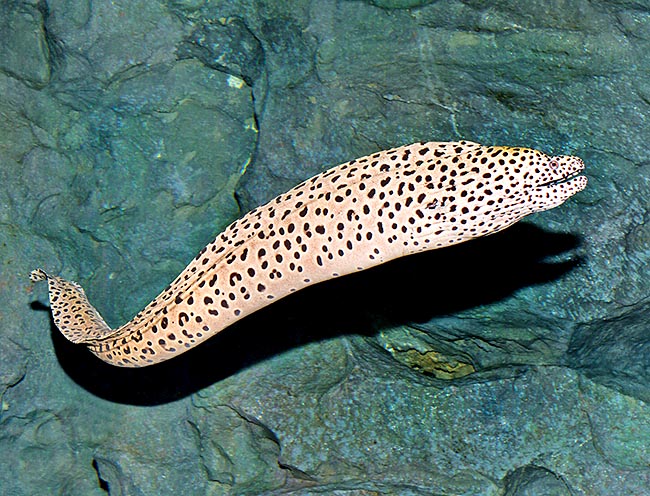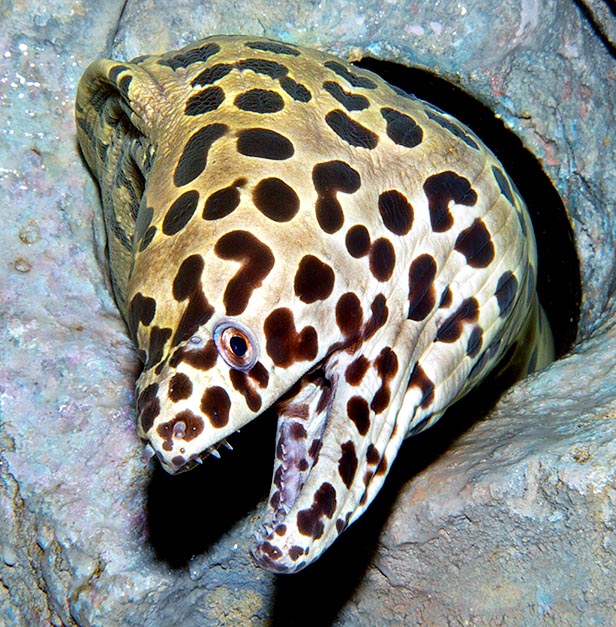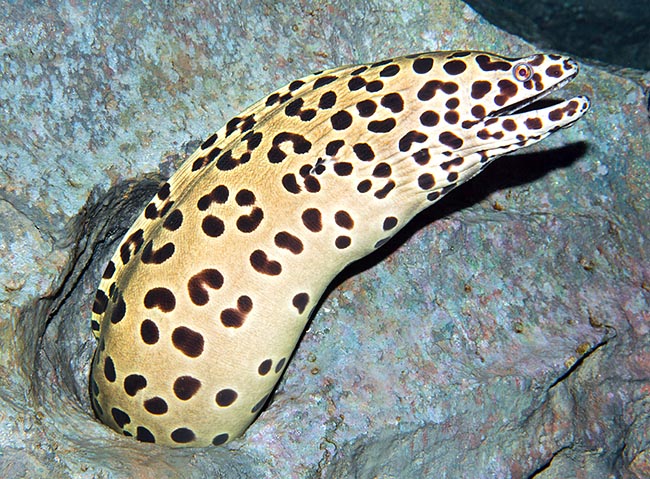Family : Muraenidae

Text © Giuseppe Mazza

English translation by Mario Beltramini

Medium sized, the spotted moray (Gymnothorax isingteena) may reach 180 cm © Giuseppe Mazza
The name of the genus Gymnothorax comes from the Greek “gymnos”, naked, and from the Latin “thorax”, thorax, with reference to the fact that unlike eels the thorax has no pectoral fins and therefore is naked.
The name of the species isingteena comes from “isingteen”, the vulgar name the Chinese use for this fish.
Zoogeography
It is a not much diffused species of the tropical Indo-Pacific. Just to give an idea, we find it at the Comoros, at Mauritius and then in Malaysia, Indonesia and in Australia, up to the southern islands of Japan.
Ecology-Habitat
It lives among the madreporic formations and in the cracks of the rocks not beyond the 30 m of depth.

Has 4 small tube nostrils for dark-hunting due to its exceptional sense of smell © Giuseppe Mazza
Of average size, it reaches the 180 cm at the most. The dorsal caudal and anal fins are merged to form a unique long cutaneous crest starting from the back and running along the tail up to the anal region. As is always the case among the morays, the pectoral fins and the ventral one are absent. The body is serpentiform, without scales, protected by slippery mucus which allows the animal to slip, without damages, in the scabrous crevices of the madrepores and of the rocks.
The eyesight is poor, but it has four nostrils for a perfect circulation of the water and of the information. The first two, having the shape of a small tube over the snout, are bent forward and the others, close to the eyes, show only a protruding ring.
The result is an exceptional sense of smell, much more useful than the sight while hunting in the night. The branchial orifices, mimetized among the spots, are reduced to two holes.
The mouth, with an enormous opening, shows also on the palate solid rows of sharp or hooked teeth for holding and tearing the preys.
On the pale brown background stand out countless dark roundish spots which at times touch thus outlining circular or horseshoe-like drawings. They are present, like the Gymnothorax favagineus, also inside the mouth, but it is impossible to mistake it with this species due to the circular and not squared shape of the spots, which do never form reticula, due to the relatively small size and the remarkable distance between them.

Unlike Gymnothorax favagineus, the small and spaced spots don't form reticula © Giuseppe Mazza
The Gymnothorax isingteena lives alone nourishing of crabs, lobsters and fishes.
The eggs, after a short ritual where the animals cling, are emitted and fecundated in surface.
The larvae, pelagic and called leptocephali, have the appearance of transparent small stripes shaped like a willow’s leaf. The head is very small and evolutively talking this is a structure showing the archaic character of this group of fishes.
The larval phase is very long; it may last several months, till the animal, assumed a cylindrical shape, does reach the reef.
The growth is slow, and even if it is a little hunted species, it has a high vulnerability risk of 78 on a scale of 100.
Synonyms
Muraena isingteena Richardson, 1845; Muraena melanospilos Bleeker, 1855; Gymnothorax melanospilos Bleeker, 1855.
→ For general information about fishes please click here.
